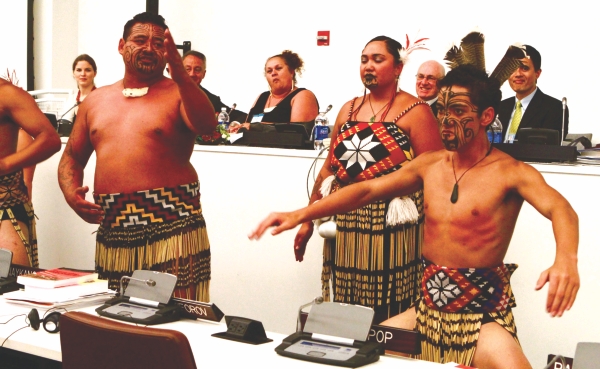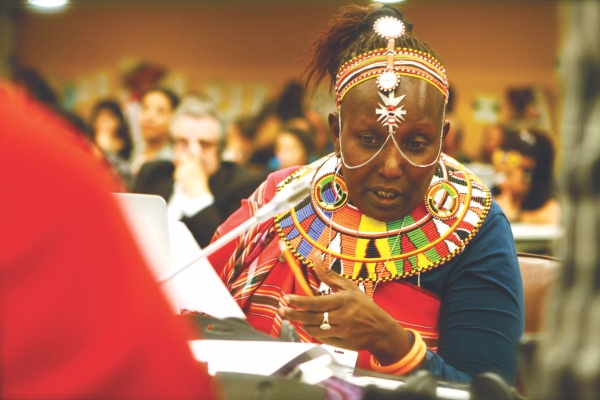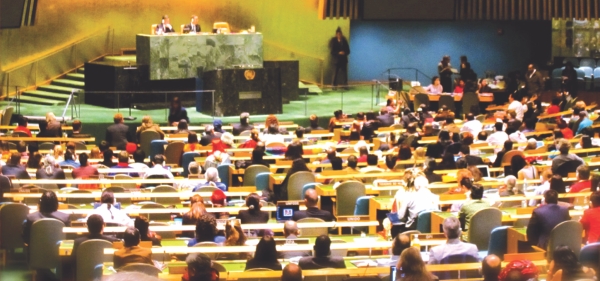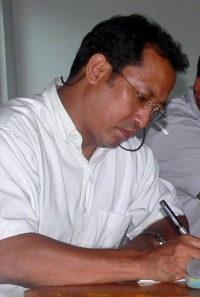Who is 'Indigenous?'
WASFIA NAZREEN elaborates on the concept of indigenousness in the context of Bangladesh.
The recent debate on 'indigenousness' in the context of Bangladesh has thrown up many questions on the appropriateness of the 'indigenous' identity of the peoples of Bangladesh, particularly the Pahari (hill) peoples of the Chittagong Hill Tracts (CHT). The government line is that the Paharis are not indigenous to Bangladesh, while Bengalis are. On the other hand, the Jumma peoples and the Plains Adibashis insist that they are indigenous peoples.
Who is right? Who are the Indigenous -- the Adibashis or the Bengalis? Or are they both indigenous?
 |
| WASFIA NAZREEN |
Context of indigenousness: Human rights vs. etymology
An informed discussion on the subject will not be possible unless we clarify the context of our discussion. The relevant context here is human rights and the framework necessarily has to be the one ascribed by that premier club of the world's sovereign states: the United Nations. Although our esteemed foreign minister is known to have cited dictionary meaning(s) of the term, 'indigenous', quoting them to be those who “belong to a particular place rather than coming to it from somewhere else”, the debate cannot be settled by referring to dictionaries, but by looking at the term's meaning as understood in the relevant UN instruments and processes and other international human-rights mechanisms, while paying appropriate attention to the political and legal contexts of Bangladesh.
And, of course, we must not ignore history. Let us therefore explore the history of settlements in Bangladesh, and the implications of the recent amendments of the constitution.
Ancestral backgrounds of the Adibashis
The most pertinent question in this respect is, were there peoples living in different parts of Bangladesh - and not necessarily spread over all parts of Bangladesh - before the arrival of the currently dominant groups (the Bengalis) in those parts of the country?
Citing the Government of Bangladesh's communication to him, the UN Special Rapporteur Martinez Cobo wrote that the government regarded members of tribal and semi-tribal populations as indigenous on account of their descent from populations which are settled in specified geographical areas of the country (emphasis added).
Thus the question is, were the different Adibashi peoples settled in the different parts of the country such as the CHT (e.g., Chakma, Marma, Tripura), the Barind tract (e.g., Santal, Munda, Oroan), the Madhupur tract (Garo, Hajong) and so forth, before the Bengalis settled there?
Indigenousness of the CHT Adibashis (Jummas)
Historical records of the Portugese, Mughals and British, and oral and written accounts of the Jummas themselves clearly attest to the fact that all the 11 Jumma peoples were in existence in the CHT-Chittagong-Feni-Noakhali-Comilla region, not just in the hills but also in the plainlands, prior to conquest (in 1666, by the Mughals of a part of Chittagong, Feni-Noakhali, Comilla, etc., but excluding the present-day CHT). Suniti Bhushan Qanungo writes: “In prehistoric times Chittagong was inhabited successively by the Austro-Asiatic and the Mongoloid groups of peoples”. He writes further, “The Mughal conquest of Chittagong drove the Arakanese beyond the hill ranges, and vacated places were occupied by new settlers from within or outside the district. The Mughal government encouraged the colonization in northwestern Chittagong, which had been depopulated during the Arakanese regime. The new colonizers, mostly the inhabitants of Noakhali-Tripura-Comilla region were the latest settlers in the district”.
Portuguese accounts refer to “Chacomas”, separately from Bengal, Arakan and Tripura in the mid-16th century. Migration of Jummas to and from present-day Bangladesh, the Indian states of Tripura and Mizoram, and Myanmar happened for centuries. It was not a one-off event. Thus it is understandable why the CHT Regulation of 1900 defined an indigenous person of the CHT as “Chakma, [Marma] or a member of any Hill tribe indigenous to the Chittagong Hill Tracts, the Lushai Hills, Arakan Hill Tracts, or the State of Tripura”.
In contrast, Bengalis were the last to settle in the CHT.
Most importantly, the CHT was not part of Bengal until after British advent. Eminent historians and sociologists therefore have noted the following: “In 1860 the British occupied the hills to the east of Chittagong and annexed them to their colonial empire. For the first time in their history, the Chittagong hills were administered from Bengal. Before that time, political power in the hills had been dispersed among many chiefs.”
Indigenousness of the Plains Adibashis
As in the case of the CHT, in the plains region as well, there is no record of Adibashis having displaced Bengalis and settled in their present locations. The Santal and Oraon made the Barind tract inhabitable and converted harsh terrain into paddy lands. Similar settlements were made by Rakhaing (Patuakhali-Barguna), Garo and Khasi (Mymensingh-Sylhet), but not by conquering and displacing Bengalis!
As in the case of the CHT, the plains Adibashis were also present in Bangladesh from before there were written histories, imperial conquests and colonisation.
Even today, despite the de-recognition, and subsequent non-recognition by the state, it is the traditional institutions that these peoples turn to for resolving their internal disputes and for carrying out other cultural activities (Manjhi: Santall, Nokma: Garo, Myntri: Khasi). They do not turn to the mainstream state-centric institutions, unlike the Bengali peoples.
Indigenousness of Bengalis
Of course, Bengalis have also lived in different parts of the plains and delta areas for centuries. Bengalis, however, have not ventured into the hill and forest areas until relatively recently. And going back to the earliest history of Bengal, prior to the arrival of the Indo-European and Dravidian-speaking peoples, the inhabitants of Bengal included several of the peoples who are claiming indigenous identity.
But the crucial point here is that by having assimilated into the dominant groups and adopting the dominant identity (regardless of the religious and nationalist aspects of that identity) Bengalis can no longer claim the indigenous mantle as it is understood in the human rights context. The indigenous concept only makes sense when the peoples are "non-dominant" in statecraft and otherwise.
Contrary to the popular belief portrayed in the media, having an 'indigenous' status does not give anyone privileges of any sort over and above that of other citizens. Essentially, it means the recognition of their full participatory rights as citizens, keeping in mind the exclusion and discrimination historically meted out to them in the process of state-formation, nation building and development, which Bengalis have enjoyed from the formation of the State. It also means the creation of an enabling environment, in which they may preserve their distinctive cultural identities, which are threatened on account of their marginal situations from the beginning of State formation.
The Debate at the UN Permanent Forum and Economic and Social Council
After the decision was taken at the ECOSOC to adopt the report of the 10th session of UNPFII, GoB was quick to put up a face-saving diplomatic response, with only China, Pakistan and Saudi Arabia showing sympathy for GoB's position. Never mind the human-rights records of the above-mentioned countries!
The Foreign Ministry's PR campaign also reported that Russia had leaned towards GoB's concern, but in fact, the position taken by Russia is just a known cautious position on IP related matters -- nothing new, and they say something like this at ECOSOC every year. What GoB, quite understandably suppressed in the media -- is the overwhelming rejection of GoB's views by states at ECOSOC of it's two major requests: 1) to agree that PFII had no mandate to discuss the CHT Accord, on the ground that the CHT Jummas were not indigenous peoples; and 2) to delete two paragraphs from the PFII's report concerning human rights violation by GoB security personnel and prevention of peacekeeping duties by HR violators.
Several news sources have referred that “Raja Devasish Roy 'led' a 12-strong team to UNPFII” -- which is factually incorrect. Raja Devasish Roy is one of the 16 Expert Members at the PFII, and it is not one of those Climate or Biodiversity conferences where he 'led' a team from Bangladesh (including Government officials) to represent our country. As an expert member at the Permanent Forum, he is a voice of entire Asia, appointed by the ECOSOC after securing an overwhelming number of votes from Indigenous organisations across the continent.
At the UNPFII, the participants from Bangladesh represented several independent organisations of our country. I was one of those 12 participants at the 10th session of UNPFII, and my organisation presented its statement on the status of the implementation of the CHT Accord, and the state of human-rights in CHT as a result of the delay in the implementation of the Peace Accord. With all due respect to Raja Devasish, I or the other Bangladeshi civil society members did not attend the PFII under his leadership. We were each sent by individual, independent organisations to participate, in my particular case, an ECOSOC-accredited member, the Ain o Salish Kendra (ASK). When the media portrays such absurd connection to his leadership roles and those who attended the PFII in our individual capacity and merits, it is feeding into an already convoluted situation fed by racist and communalist misinformation campaign.
 |
| WASFIA NAZREEN |
Indigenousness in UN instruments and practices
Definition
According to the UN the most fruitful approach is to identify, rather than formally define indigenous peoples and hence there is no set definition of indigenous peoples in the UN Declaration on the Rights of Indigenous Peoples. However, International laws do not define minorities either. The “working definition” of indigenous peoples by José R Martínez Cobo has attained the status of a near-formal definition in the context of UN and International human rights jurisprudence. Cobo writes: “Indigenous communities, peopless and nations are those which, having a historical continuity with pre-invasion and pre-colonial societies that developed on their territories, consider themselves distinct from other sectors of the societies now prevailing on those territories, or parts of them. They form at present non-dominant sectors of society and are determined to preserve, develop and transmit to future generations their ancestral territories, and their ethnic identity, as the basis of their continued existence as peopless, in accordance with their own cultural patterns, social institutions and legal system.” (My emphasis added)
The ILO Conventions 107 (ratified by GoB)
We should be examining first and foremost the concept in relation to the ILO Convention on Indigenous & Tribal Populations (Convention No. 107) of 1957, which Bangladesh ratified in June, 1972, under the leadership of Bangabandhu Sheikh Mujibur Rahman, about six months before the Constitution of Bangladesh was adopted.
2.1. Pre-colonisation or pre-conquest social, cultural and economic institutions
As a collective entity, Bengalis live less in conformity with the “social, economic and cultural institutions” of the time of their pre-colonisation or pre-conquest period ancestors, and more in conformity with “the institutions of the nation to which they belong”, and hence they cannot be regarded as indigenous within the meaning of Convention 107.
In contrast, hill communities of the CHT, and Adibashi groups of the plains, “irrespective of their legal status” are quite the opposite. Traditional institutions in the CHT are formally recognized by law, and while those in the plains are not -- still conform to their ancestral institutions' traditions norms and mores.
In the case of “economic institutions”, Bengalis clearly do not retain very many practices of the pre-colonial or pre-conquest period, unlike Pahari groups, for example collective forest management, subsistence-oriented jum or “shifting” cultivation, etc.
2.2. Indigenous are tribal
It is clear from the wording of ILO Convention No. 107 that 'indigenous' and 'tribal' population groups are both referred to as “tribal or semi-tribal” populations. Therefore, indigenous populations are those among the tribal and semi-tribal population groups who “[are descended] from the populations which inhabited the country, or a geographical region to which the country belongs, at the time of conquest or colonization and which, irrespective of their legal status, live more in conformity with the social, economic and cultural institutions of that time than with the institutions of the nation to which they belong”.
2.3. Social, economic and other position of disadvantage
The concept of tribal and semi-tribal population groups has been related in this convention with “social and economic conditions [that] are at a less advanced [read disadvantaged] stage than the stage reached by the other sections of the national community”, and a “status [that] is regulated wholly or partially by their own customs or traditions or by special laws or regulations”.
The concept of indigenous peoples is meaningless in the case of Bengalis from a human rights perspective because Bengalis are at the helm of state power, while the Adibashis were, and still are, substantively, the 'excluded' citizens, marginalised and disadvantaged.
GoB at the UN in the past
From the final report on the Study of the Problem of Discrimination Against Indigenous Populations submitted on June 20, 1982 to the UN Working Group on Indigenous Populations by Mr. José Martínez Cobo, a Special Rapporteur, it is documented that the then Bangladesh Government clearly recognised the existence of the Indigenous Peoples in Bangladesh. The report looked at a number of criteria in defining Indigenous Peoples, and reported how different governments define the Indigenous Peoples in their countries.
Let's look at how the then Bangladesh Government defined and recognised the Indigenous Peoples in Bangladesh. Under the Ancestry criteria: “In Bangladesh, the Government states that the members of Tribal or Semi-tribal populations are regarded as indigenous “on account of their descent from the populations which are settled in specified geographical areas of the country.” (Emphasis added).” Under the Culture and Language criteria: “In Bangladesh some of these isolated or marginal groups are said to “speak a language of their own, have their own dances, music and love songs and a uniform style of home, dress, food and customs distinct from the other tribes”, in some cases also including religions which may be “a mixture of Buddhism and totemism”. Several of these groups are described as “small communities leading a life undisturbed by alien influences” for a very long time “because of the heavy monsoon that cuts off their area from the outside world for much of the year.”” Several similar recognitions by the GoB can be found in the historic document in the link provided.
The 15th Amendment terminology and why it does not work?
- Upajati
Anyone who is fluent in English and Bengali will find it humorous that the terms 'tribe/tribal' can even remotely be translated to the word 'Upa-jati' -- literally meaning 'sub-nation' or 'sub-ethnic groups.' Who is the sub-group here and who is the larger ethnic group? Are we calling the Adibashis the sub-groups of Bengalis?
-Khudro jatishotta
The term 'khudro jati-shotta' may seem more respectable towards the separate cultural entity of the non-Bengali peoples, but it is nevertheless, problematic, as there is a clear distinction of hierarchical division of peoples (smaller and greater!).
-Khudro nrigoshthi
“Khudro nri-goshthi” or small ethnic groups is also problematic. In the first place, the indigenous peoples and the Bengali peoples are both ethnic groups or ethnic communities, and the 'smallness' of the population of the indigenous peoples should not be the basis to distinguish between the different ethnic groups.
 |
| WASFIA NAZREEN |
-Khudro shomprodai
Our honourable FM, Dipu Moni mentioned that when the Indigenous peoples are only 1.2% of the total population, giving them a special and 'elevated' identity cannot be in the national interest of our country. By this point, one must see how the Government is clearly stuck on the word “Khudro” -- potent in power and paralysed by fear. Khudro shomprodai is also problematic on account of the reference to smallness. Without the khudro, this term is not disparaging.
Nevertheless, khudro (small) or brihot (large), the constitution refers to jatishotta. Jatishotta is surely either a peoples or nation, in English. And jatishottahood, peoplehood or nationhood has nothing to do with the size or population of the group concerned and of their indigenous or other status. At the same time, deleting 'indigenous' and all related phrases from Government documents will neither erase the consciousness of those who are Indigenous, nor affect the conscience of those who have been fighting with them.
The spirit of the CHT Regulation and customary laws are embedded in the customs of Bangladesh, which cannot be uprooted merely by a change of terms. In an important case before the Supreme Court on the succession of the Bohmong chieftain-ship, the court stated that neither the GoB nor the Court had the right to interfere with customary laws. Thus the Customary laws of the Indigenous Peoples of Bangladesh are now part of the customs of the Republic and cannot arbitrarily be revoked through mere legislation, particularly where that contravenes the constitutional tenets of non-discrimination.
Having said that, the entire exercise smacks of crass and feudal times discriminatory acts. It would be equivalent to legislation in Europe and America -- or this country for that matter -- to overturn the positive legal developments regarding non-discrimination on race, gender and so forth. If GoB wants to continue to be the laughing-stock in the world podium of progressiveness -- the curtains are raised, refreshments have sold-out… all are queuing up for some good laughs, at the expense of our national image.
1. Ethnic minority, not indigenous people, FM tells diplomats, editors, Daily Star, July 27, 2011.
2. Commission on Human Rights, Study of the problem of discrimination against Indigenous Populations, Jose R. Martinez Cobo (1982: paragraph 61).
3. Suniti Bhushan Qanungo, A History of Chittagong, Vol 1, published by Dipankar Qanungo, Chittagong, 1988, p. 20.
4. Ibid, p. 21.
5. S. N. H. Rizvi (ed), East Pakistan District Gazetteers: Chittagong, Government of East Pakistan, Services and General Administration Department, East Pakistan Government Press, Dacca, 1970, p. 75.
6. Willem van Schendel, Wolfgang Mey & Aditya Kumar Dewan, The Chittagong Hill Tracts: Living in a Borderland, White Lotus Press, Bangkok, 2000, p. 25.
7. Chakma Raja decries non-recognition, Sun, 29/05/2011 by priyodesk; News Source: The New Age
8. Article 1(1)(b), ILO Convention No. 107.
9. Ibid.
10. Ibid.
11. Ibid.
12. Article 1(1)(a), ILO Convention No. 107.
13. The URL address of the report is http://www.un.org/esa/socdev/unpfii/en/spdaip.html
14. Page 15 of E/CN.4/Sub.2/1982/2/Add.6, No: 61.
15. Page 18 of E/CN.4/Sub.2/1982/2/Add.6, No: 86.
16. Aung Shwe Prue Chowdhury v. Kyaw Sain Prue Chowdhury & Others (50 DLR AD (1998) 73)
Wasfia Nazreen is a member of Drishtipat Writers' Collective (www.drishtipat.org/dpwriters) and was a delegate of Ain o Salish Kendra (ASK) at the 10th session of United Nations Permanent Forum on Indigenous Issues (UNPFII). She can be reached at wasfia@drishtipat.org.
-----------------------------------------------------------------------------------------------------------------















